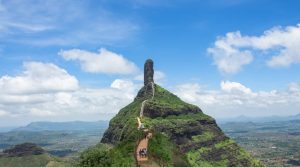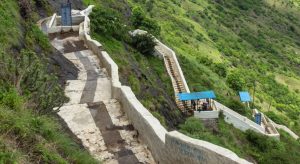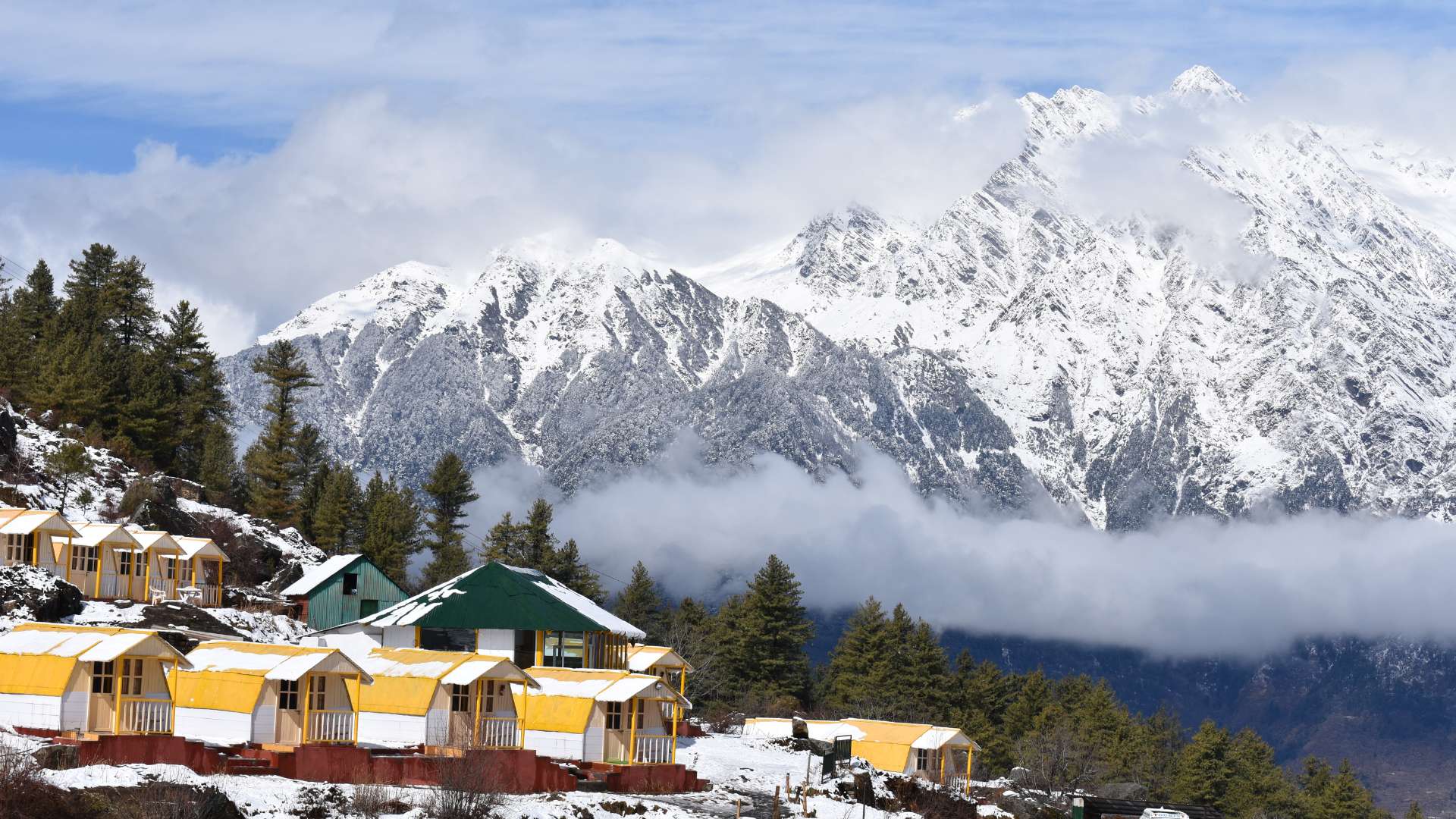Table of Contents
ToggleHave you ever encountered a place where spiritual energy feels almost tangible in the air? Located in the Satana Taluka of Maharashtra, Mangi Tungi Jain Temple is one such sacred destination that blends ancient history, religious devotion, and breathtaking natural beauty.
Known as a Siddha Kshetra in Jainism, it is believed that 99 crore ascetics, including revered figures like Lord Ram, Hanuman, and Lord Krishna, attained moksha here.
The site is home to the Statue of Ahimsa, a 108-foot monolithic idol of Lord Rishabhdev, which holds the title of the world’s tallest Jain idol.
Whether you’re a pilgrim, a spiritual seeker, or a cultural explorer, Mangi Tungi offers a soul-stirring journey through faith, mythology, and awe-inspiring architecture high in the hills of Maharashtra.
What Makes Mangi Tungi Jain Temple a Unique Spiritual Destination?

Have you ever encountered a place where spiritual energy feels almost tangible in the air? Located in the Satana Taluka of Maharashtra, Mangi Tungi Jain Temple is one such sacred destination that blends ancient history, religious devotion, and breathtaking natural beauty.
Known as a Siddha Kshetra in Jainism, it is believed that 99 crore ascetics, including revered figures like Lord Ram, Hanuman, and Lord Krishna, attained moksha here.
The site is home to the Statue of Ahimsa, a 108-foot monolithic idol of Lord Rishabhdev, which holds the title of the world’s tallest Jain idol.
Whether you’re a pilgrim, a spiritual seeker, or a cultural explorer, Mangi Tungi offers a soul-stirring journey through faith, mythology, and awe-inspiring architecture high in the hills of Maharashtra.
What Is the History Behind Mangi Tungi?
Mangi Tungi Jain Temple, situated in Bhilwadi village near Satana, holds deep roots in Indian mythology and Jain philosophy. The site is believed to be a Siddha Kshetra, where 99 crores (990 million) ascetics attained liberation.
This list includes prominent figures from both Jain and Hindu traditions, such as Lord Ram, Sita, Hanuman, Krishna, and Balram.
These revered personalities are believed to have meditated and attained moksha on the twin peaks—Mangi (4,343 ft) and Tungi (4,366 ft). Over time, their spiritual legacy transformed this location into a significant pilgrimage site.
Today, it attracts devotees from across the country who come to connect with its timeless energy and historical depth. Mangi Tungi is not merely a temple it is a living archive of devotion, asceticism, and liberation.
Why Is the Statue of Ahimsa So Architecturally Significant?
One of Mangi Tungi’s most remarkable features is the Statue of Ahimsa, a colossal image of Lord Rishabhdev, the first Tirthankara of Jainism. Recognised by the Guinness World Records, this statue is the tallest Jain idol in the world.
| Feature | Description |
| Height | 108 feet (approx. a 10-storey building) |
| Base Area | 184 square feet |
| Carved From | Single basalt rock of Tungi Hill |
| Posture | Kayotsarga (standing meditation) |
| Significance | Symbol of non-violence (Ahimsa), detachment, and liberation |
| Construction Timeline | Took over 10 years to complete |
| Inaugurated In | February 2016 |
| Recognition | Guinness World Record holder |
The statue not only celebrates the principle of Ahimsa (non-violence) but also reflects architectural brilliance and religious devotion. Positioned atop Tungi Hill, the statue dominates the skyline and serves as a beacon for pilgrims and admirers of spiritual art.
What Is the Religious Importance of Mangi Tungi for Jains?
Mangi Tungi holds a position of utmost reverence in Jainism due to its status as a Siddha Kshetra, where countless ascetics are said to have reached moksha. This makes it a liberation zone, much like Shikharji or Girnar.
The significance of this site extends beyond Jainism. Figures such as Ram, Krishna, Balram, and Hanuman, central to Hinduism, are believed to have also meditated here, further increasing its religious value.
Every year, thousands of pilgrims ascend the 3,000+ steps not just to worship, but to walk the sacred path believed to lead to spiritual awakening and karmic cleansing.
For Jains, a visit here is a mark of devotion and a step closer to liberation.
What Will You Discover at the Mangi and Tungi Peaks?

The twin peaks of Mangi and Tungi are home to hundreds of temples, cave sanctuaries, and ancient carvings. Each peak holds distinct spiritual value and unique attractions.
| Peak | Attractions | Unique Insights |
| Mangi Hill | Caves with idols of Ram, Sita, Hanuman, and many small temples | Believed to be the site where Ram and Hanuman attained moksha |
| Tungi Hill | Idols of Krishna, Balram, and numerous Tirthankaras | Moksha place for Lord Krishna and Balram, with inscriptions in Brahmi and Pali |
Over 400 temples and cave structures exist across both hills, featuring thousands of finely carved stone idols. These carvings are often accompanied by ancient inscriptions that highlight the religious, historical, and artistic heritage of Jainism and Indian spirituality.
The peaks also offer panoramic views, inviting visitors into a realm of silence and self-reflection.
When Is the Best Time to Visit Mangi Tungi Jain Temple?
Timing your visit to Mangi Tungi can deeply influence your overall experience. Here’s a breakdown of the best times to go:
| Season | Highlights |
| October to February | Best time to visit. Cool, clear weather ideal for trekking. |
| Kartik Purnima | Celebrated with spiritual processions and rituals. High footfall. |
| Mahavir Jayanti | Large gatherings and special prayers. |
| March to May | Warmer temperatures. Mornings are suitable for the climb. |
| June to September (Monsoon) | Not recommended. Slippery steps and dense fog reduce safety and visibility. |
Early mornings are ideal for the trek due to pleasant weather and fewer crowds. If visiting during the festival seasons, book accommodations in advance, as local dharamshalas get filled quickly.
How Can You Reach Mangi Tungi Temple from Major Cities?
Reaching Mangi Tungi is convenient thanks to its proximity to Nashik and connectivity through multiple modes of transport. The pilgrimage typically starts from Bhilwadi village, the base point.
| Travel Mode | Details |
| By Road | Drive from Nashik (125 km) via Satana. Buses and taxis available. |
| By Rail | Nearest station is Nashik Road. Cabs/buses connect to Bhilwadi. |
| By Air | Ozar Airport (Nashik) is about 115 km away. |
| On Foot | 3,000+ carved stone steps from Bhilwadi to the twin peaks. |
For elderly pilgrims or those with mobility concerns, palkhi (palanquin) services may be arranged during festival seasons or peak times.
What Facilities and Accommodations Are Available for Pilgrims?

While Mangi Tungi is a remote location, it offers sufficient basic amenities for pilgrims and travellers. Here’s what to expect:
| Category | Details |
| Clothing | Wear modest, breathable clothes suitable for climbing and temples. |
| Footwear | Comfortable walking or trekking shoes are recommended. |
| Food | Jain food is available at dharamshalas and local stalls. Carry dry snacks. |
| Medical Support | Carry basic first-aid and any required medication. |
| Spiritual Etiquette | Maintain silence, respect local customs, and avoid littering. |
| Accessibility | Palkhi services for the elderly; steps may be steep for some. |
| Stay Options | Dharamshalas offer simple, clean accommodation with vegetarian meals. |
Booking accommodation in advance is advisable, especially during festivals or religious events.
What Should You Know Before Visiting Mangi Tungi Jain Temple?
Before embarking on your spiritual journey to Mangi Tungi, keep the following in mind:
- Respect the religious and cultural importance of the site.
- Avoid loud behaviour and follow traditional temple decorum.
- Photography is allowed but should be respectful, especially around idols.
- Carry plenty of water and wear sun protection for the climb.
- Avoid plastic and maintain the natural sanctity of the hills.
With thoughtful preparation, your visit becomes not just a journey of discovery but also of deep inner peace.
How Has Mangi Tungi Grown in Popularity Among Tourists?
In recent years, Mangi Tungi has evolved from a regional pilgrimage site to a national religious tourism hotspot. The completion of the Statue of Ahimsa and its recognition by the Guinness World Records significantly boosted its visibility.
Maharashtra’s tourism department, Jain communities, and travel bloggers have contributed to its rise in popularity. Documentaries and features on the spiritual relevance and ecological serenity of the site have further drawn attention.
As infrastructure improves, the site is expected to welcome even more visitors while continuing to preserve its sanctity and traditions.
Conclusion
The Mangi Tungi Jain Temple is more than a religious destination it is a profound experience of devotion, history, and natural beauty. From the remarkable Statue of Ahimsa to the serene caves and ancient peaks, every element of this sacred site resonates with peace and timeless wisdom.
If you seek clarity, solitude, and spiritual upliftment, Mangi Tungi delivers on all fronts. It is not merely a destination, it is a journey that stays with you long after you descend its sacred steps.
FAQs
What is the spiritual significance of Mangi Tungi in Jainism?
It is a Siddha Kshetra where 99 crore ascetics are believed to have attained moksha, making it one of Jainism’s holiest sites.
Is it possible to visit Mangi Tungi in a single day?
Yes, but it is recommended to stay overnight in Bhilwadi or Satana for a more relaxed experience, especially if you intend to climb both peaks.
Are children allowed at the temple?
Children can visit but the climb may be physically challenging for very young kids. Carry essentials like water, snacks, and sun protection.
What kind of food is available?
Only vegetarian and Jain food is served in local dharamshalas and stalls. Visitors are advised to carry dry snacks and water.
How long does it take to climb Mangi Tungi?
The average climb takes about 2 to 3 hours, depending on your pace and breaks. You can extend your time to explore the caves and statues.
Is mobile connectivity available?
Mobile network is available in the base village, but it may be weak or unavailable at higher altitudes.
Are there any guided tours available?
Local guides may be available, especially during festivals. It’s advisable to check with dharamshala authorities or temple offices.









